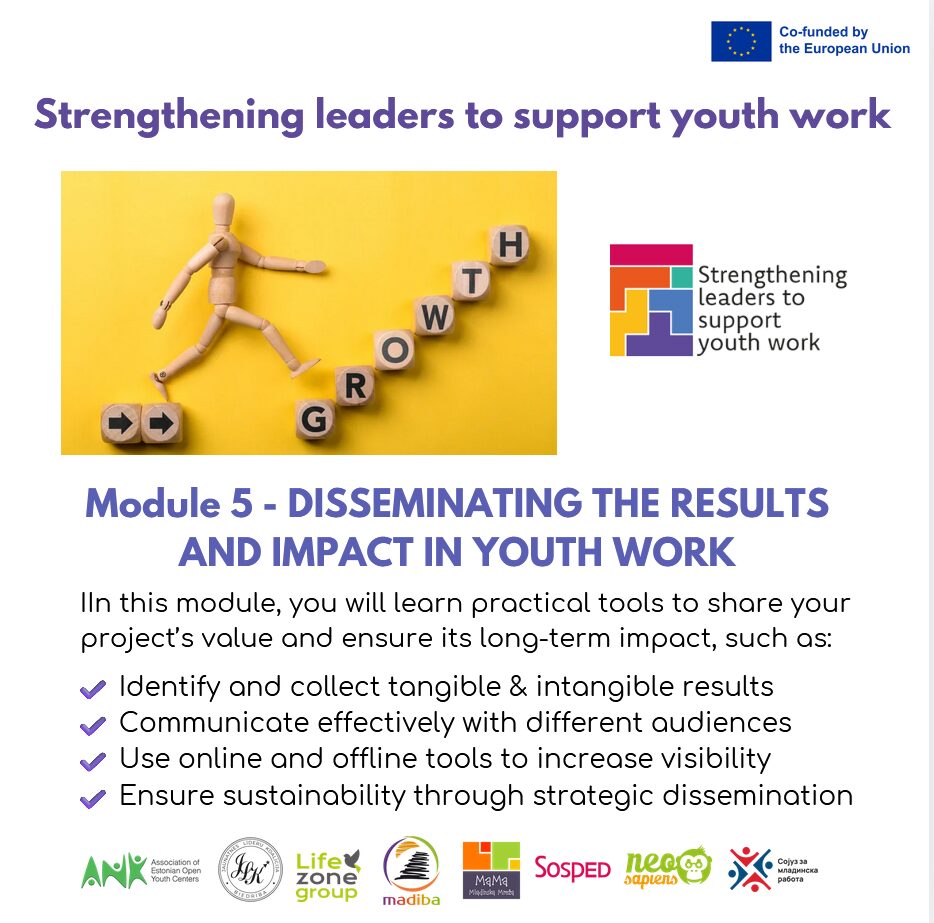
MOdule 5 - Disseminating the results and impacts of youth work
PART 5.1.
Introduction to the Module
This training module is designed to support leaders, managers, and directors working in the youth field (hereafter – the leaders) in strengthening the visibility, reach, and impact of their work by mastering dissemination practices. It focuses on equipping learners with the knowledge, tools, and strategies needed to communicate results clearly, engage relevant stakeholders, and ensure that youth work outcomes are recognised, shared, and sustained.
Each year, thousands of youth projects are implemented across Europe, enriching the lives of young people and generating a wealth of knowledge, experiences, and innovative practices. Yet, too often, these valuable results fade into obscurity once the project ends — the reports are submitted, the photos filed away, and the impact remains known only to those directly involved. Despite significant investment and potential, many project outcomes lack the visibility they deserve and are rarely reused, shared, or built upon. With just a bit more planning and strategic effort, these projects could have far greater reach — inspiring others, influencing systems, and giving greater visibility and value to the work of the youth sector well beyond their original scope.
To better understand the realities faced by youth organisations, our team conducted a dedicated study involving 100 leaders of youth organisations from across Europe. The research revealed that while youth work professionals are highly committed to making a difference, they often face substantial challenges when it comes to disseminating their project results and communicating impact.
Many of these challenges stem from limited resources — both in terms of time and budget — which make it difficult to prioritise dissemination efforts. Skills gaps in communication, marketing, and digital engagement further complicate the picture, especially for those whose strengths lie in direct youth work rather than public outreach. Leaders frequently struggle with how to measure and present qualitative outcomes like increased confidence or improved social skills in ways that resonate with funders and decision-makers.
Dissemination also requires tailoring messages for a wide range of audiences, from young people and local communities to public institutions and EU bodies — each needing different formats and levels of detail. This complexity is made even more difficult by the absence of clear frameworks or benchmarks for dissemination in the youth sector. In some organisations, dissemination is still seen as secondary to programme delivery, and leaders must often advocate internally for its value.
On top of this, ethical considerations, privacy concerns, and the rapid evolution of digital tools demand a level of adaptability and strategic thinking that often goes beyond the current skills and resources of many organisations. Taken together, these barriers create a gap between the great work being done in the youth field and the visibility and long-term recognition it deserves.
This module was designed precisely in response to these challenges — providing leaders with practical, strategic tools to overcome common obstacles and ensure that their work is seen, understood, and sustained.
What to expect:
This module supports youth work leaders in making their project results more visible, valued, and long-lasting. It offers clear guidance on how to develop and manage a strategic dissemination approach that supports both recognition and sustainability. It also emphasises the importance of aligning dissemination and communication efforts with the organisation’s broader vision and mission, ensuring coherence, credibility, and long-term strategic value.
Participants will:
- Understand how visibility, dissemination, and exploitation differ — and how they work together;
- Learn to design effective communication plans aligned with project goals and audiences;
- Explore tools for engaging stakeholders both inside and outside the organisation;
- Craft targeted, evidence-based messages for diverse audiences;
- Discover how to ensure project results remain relevant and in use over time;
- Gain confidence in using monitoring tools to track and report on dissemination efforts.
The module places strong emphasis on early planning and provides step-by-step guidance to integrate communication throughout the project lifecycle. It includes short presentations, videos, reflection exercises, planning templates, and links to further learning.
By the end, participants will be able to design and implement a results dissemination strategy that raises visibility and ensures long-term impact across local, national, and European levels.
The aim of this module is to equip youth work leaders with a strategic mindset and practical tools to effectively and sustainably disseminate the results of their projects—enhancing visibility, engaging stakeholders, and ensuring long-term impact across local, national, and European levels.
The module includes the following topics:
- Strategic approach to the visibility and dissemination of youth work results.
- External communication: engaging stakeholders in results dissemination.
- Internal communication: teams as project results dissemination ambassadors.
- Communication plan development and management.
- Crafting effective messaging for different target audiences.
- Projects results dissemination and sustainability.
- Measurement, monitoring and reporting of the dissemination activities results - quantitative measurement tools.
The objectives for the module are:
- Understand strategic approach to the youth work results dissemination / Participants will learn to define clear dissemination objectives, identify target audiences, and select appropriate communication channels for their youth work results.
- Enhance visibility and presence / Participants will gain skills to assess and improve their organisation’s online and offline visibility, ensuring effective engagement with stakeholders.
- Develop compelling narratives / Participants will master storytelling techniques to transform data and project results into engaging stories that resonate with diverse audiences.
- Leverage internal team strengths for dissemination / Participants will understand how to empower their team as ambassadors, fostering a strong internal communication culture to support dissemination efforts.
- Effectively engage communities / Participants will learn strategies for building and managing communities that actively support and amplify dissemination efforts.
- Utilize modern digital tools / Participants will become familiar with a range of digital tools for content creation, social media management, and analytics, tailored to non-profits.
- Apply EU standards in dissemination / Participants will gain knowledge of funding institutions expectations and best practices for dissemination, ensuring their strategies align with local, national and European guidelines.
- Measure and improve dissemination efforts / Participants will learn to track and evaluate the effectiveness of dissemination activities, using data to refine their approaches for better results.
PART 5.2.
Introduction and main ideas
Youth work plays a crucial role in empowering young people, fostering social inclusion, and strengthening communities. However, for youth work to gain the recognition and support it deserves, its impact must be effectively communicated to stakeholders, policymakers, and society at large. Dissemination is not just about reporting results—it is about ensuring that youth work influences policies, secures funding, and inspires further action.
This unit, "Dissemination of Impacts of Youth Work", equips youth sector leaders and managers with the tools and strategies needed to share the outcomes of their work in meaningful and engaging ways. Learners will explore the importance of aligning impact dissemination with organisational goals, identifying key stakeholders, and tailoring communication to different audiences.
The training will introduce innovative storytelling techniques, digital platforms, and analytical tools to enhance the visibility and credibility of youth work. It will also emphasise the role of internal teams in dissemination and provide methods for evaluating and improving dissemination efforts. Through practical exercises and real-world examples, participants will develop actionable strategies to amplify the reach and influence of youth work.
Aims of the Training
This training aims to strengthen the ability of youth sector managers to effectively disseminate the impacts of youth work and advocate for its value. By the end of this unit, participants will be able to:
-
Recognize the broader relevance of youth work impacts and their contribution to policy development and societal change.
-
Develop effective dissemination strategies by defining objectives, identifying target audiences, and choosing appropriate communication channels.
-
Use data-driven advocacy to translate evidence into compelling narratives for stakeholders and policymakers.
-
Engage and empower teams to actively contribute to impact dissemination and internal communication.
-
Apply digital tools and creative methods to enhance storytelling and outreach.
-
Monitor and evaluate dissemination effectiveness, using feedback and analytics to refine strategies.
By mastering these skills, participants will be able to enhance the visibility, sustainability, and influence of youth work, ensuring that its benefits are recognized and supported across different sectors.
 WAY TO TH!NK
WAY TO TH!NK